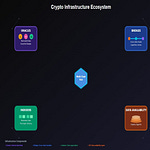In the early days, blockchain was a fascinating experiment. Today, it’s a technology poised to reshape finance, supply chains, and digital ownership. But for every vision of a decentralized future, a critical question arises: can these networks handle the world’s demand? This is the problem of scalability, and its solution is the key to unlocking blockchain's real-world potential.
This article, the fourth in our "Core Tech" series, dives deep into the world of blockchain scaling. We'll explore the ingenious solutions engineers have devised to break the "blockchain trilemma" — the challenge of achieving decentralization, security, and scalability simultaneously.
a) What is Blockchain Scaling and Why Does it Matter?
At its core, blockchain scaling is the process of increasing a network's capacity to process more transactions per second (TPS), reduce latency (confirmation time), and lower transaction fees (gas fees), all without compromising on security or decentralization.
Why is it critical? Imagine a global financial system running on a network that can only process 15-30 transactions per second (like early Ethereum or Bitcoin). It would be impossibly slow and prohibitively expensive. For blockchain to move beyond speculation and into real-world problem-solving—powering micropayments, global remittances, or complex decentralized applications (dApps)—it must scale to handle thousands, if not millions, of TPS.
There are three primary approaches to scaling:
Layer 1 (L1) Scaling: Modifying the base protocol itself.
Layer 2 (L2) Scaling: Building protocols on top of the base layer to handle transactions off-chain.
Hybrid & Other Solutions: Innovative techniques that combine elements of both or introduce new paradigms.
b) Layer 1 Scaling: Reinventing the Foundation
Layer 1 solutions involve changing the core rules of the blockchain protocol to increase its capacity and speed.
Proof-of-Stake (PoS): Replacing the energy-intensive Proof-of-Work (PoW) mining with a system where validators "stake" their own cryptocurrency to secure the network. This is vastly more efficient, allowing for faster block creation and higher throughput.
Example: Ethereum itself made the monumental shift from PoW to PoS in "The Merge," laying the groundwork for its scaling roadmap.
Sharding: This involves splitting the blockchain's entire state into smaller, more manageable pieces called "shards." Each shard processes its own transactions and smart contracts, parallelizing the workload. The main chain (the Beacon Chain in Ethereum's case) coordinates the shards and ensures security.
Example: Ethereum's Danksharding (part of its future roadmap) and Near Protocol, which uses a form of sharding called "Nightshade."
Increasing Block Size/Speed: A simpler method of increasing throughput by allowing more transactions per block (bigger blocks) or creating blocks more frequently (faster blocks).
Example: Bitcoin Cash (BCH) forked from Bitcoin primarily to increase block size. Solana achieves high speed through a combination of incredibly fast block times and a unique consensus mechanism (Proof-of-History).
c) Layer 2 Scaling: Building Express Lanes on a Secure Highway
Layer 2 solutions are secondary frameworks or chains that operate on top of a Layer 1 blockchain. They handle transactions off-chain and then post finality proofs or batched data back to the main chain, inheriting its security.
Rollups: Execute transactions outside the main chain but post transaction data to L1. They are considered the gold standard for L2 scaling.
Optimistic Rollups: Assume transactions are valid (optimistic). They only run computations and fraud proofs if a transaction is challenged. This allows for high throughput and EVM compatibility.
Example: Arbitrum and Optimism.
ZK-Rollups (Zero-Knowledge): Use cryptographic validity proofs (ZK-SNARKs/STARKs) to instantly prove the correctness of all transactions. They offer faster finality and stronger security guarantees but are more complex to build.
Example: zkSync Era, Starknet, and Polygon zkEVM.
Sidechains: Independent blockchains that run parallel to the main chain and have their own consensus mechanisms and security models. They connect to the main chain via a two-way bridge.
Example: Polygon PoS (though it's evolving into a full L2 ecosystem with zk-tech) and Gnosis Chain.
State Channels: Allow participants to conduct a long series of transactions off-chain, only opening and closing the channel with two on-chain transactions. Ideal for micropayments or gaming.
Example: Bitcoin's Lightning Network and Ethereum's Raiden Network.
Validiums & Volitions: These are variations of ZK-Rollups.
Validium: Uses validity proofs like a ZK-Rollup but stores data off-chain. This offers huge throughput but less data availability security.
Volition: A hybrid model where users can choose for each transaction whether their data is stored on-chain (as a rollup) or off-chain (as a validium).
Example: Immutable X (a Validium for NFTs) and StarkEx (which offers a Volition model).
d) Hybrid and Other Innovative Solutions
The line between L1 and L2 is blurring with new, fundamental technologies.
Data Availability Sampling (DAS): A critical technology for scaling without requiring every node to download all data. Light nodes can sample small, random pieces of block data to verify with high probability that all data is available. This is the backbone of Ethereum's proto-danksharding (EIP-4844) and danksharding, enabling cheap blob space for L2s.
Modular Blockchains: This paradigm breaks blockchain functions into specialized layers: Execution, Settlement, Consensus, and Data Availability. L2s are a form of modularity, but projects like Celestia (focusing on Data Availability and Consensus) and EigenLayer (restaking for shared security) are pushing this concept further.
e) Scaling Through Specialized Forks: The HyperEVM Example
The open-source nature of code like the Ethereum Virtual Machine (EVM) allows teams to fork and heavily optimize it for specific use cases, often achieving radical performance gains.
A prime example is Hyperliquid's HyperEVM. Hyperliquid is a decentralized exchange (DEX) focused on perpetual futures trading, which demands extreme speed and low cost. Instead of building on a general-purpose L2, they forked the Go-Ethereum client to create HyperEVM, a purpose-built L1 that is:
EVM-Compatible: It can run Solidity smart contracts, allowing developers to easily port their dApps.
Radically Optimized: It strips out unnecessary overhead from the standard EVM, tailoring every aspect for the high-frequency trading environment of a perps DEX.
This represents a trend: application-specific blockchains (appchains) that sacrifice generalizability for maximal performance in a single domain.










